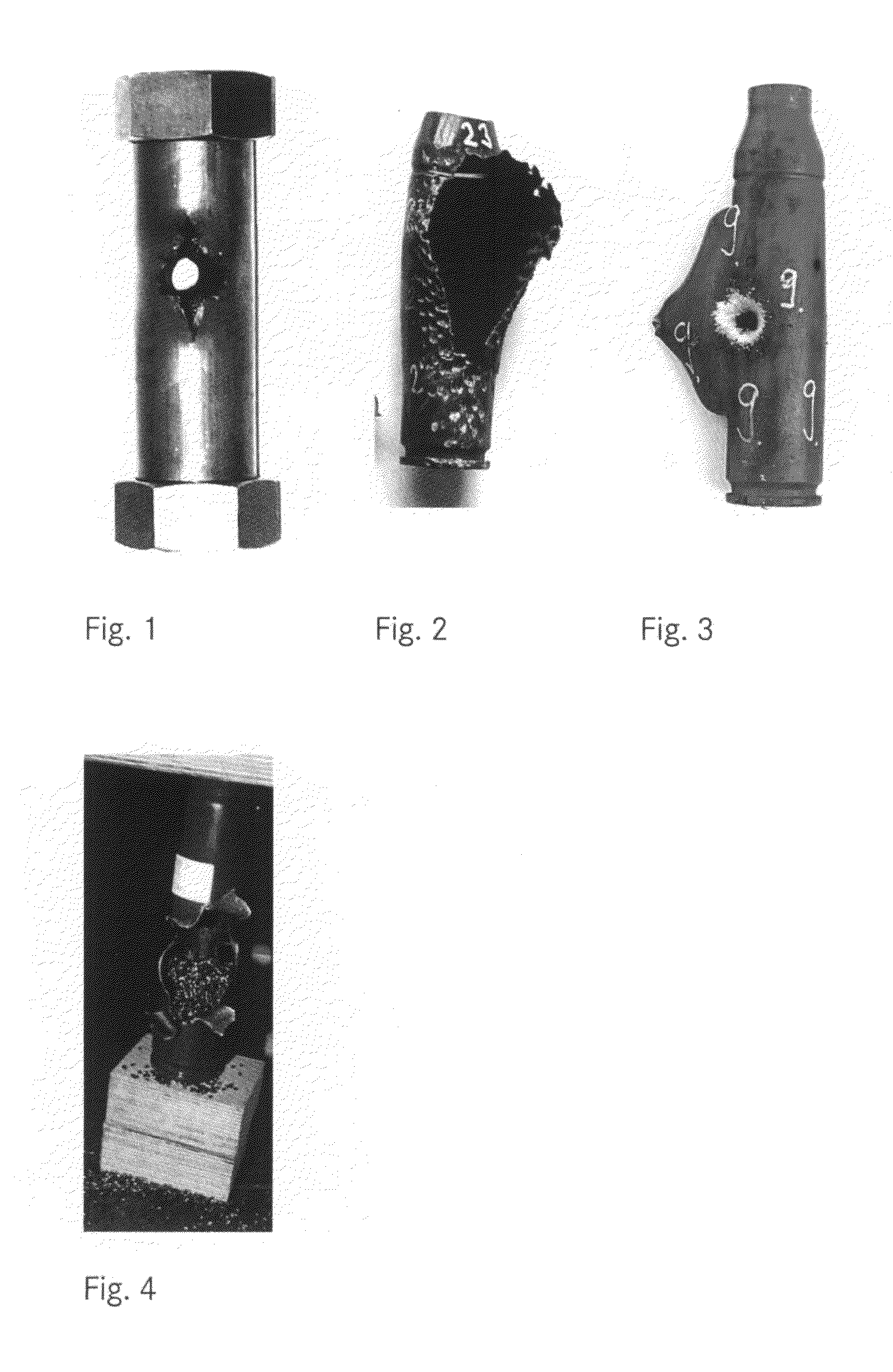Propulsion system for the acceleration of projectiles
a technology of projectiles and propulsion systems, applied in the direction of weaving, looms, nitrocellulose explosive compositions, etc., can solve the problems of increased threat, ammunition vulnerability, and only being able to offer insufficient protection for weapons and ammunition platforms currently in use, and achieves the effect of good value and convenient availability
- Summary
- Abstract
- Description
- Claims
- Application Information
AI Technical Summary
Benefits of technology
Problems solved by technology
Method used
Image
Examples
example 1
[0066]5 kg of a 7-hole green powder heated up to 60° C. are manufactured, in a process in which a powder cake made up in the solid proportions of 25% by weight RDX, 1.8% by weight of Akardit-II, 0.4% by weight of calcium sulphate, 0.2% by weight of lime, 0.1% by weight of manganese oxide, 1.5% by weight of a phthalic acid ester (which is constituted predominantly from linear C9-C11 alcohols with an average molecular weight of 450 g / mol and an average dynamic viscosity at 20° C. of 73 mPa*s) and nitrocellulose with a nitrogen content of 13.20% by weight (supplementation to 100%) is worked into a solvent-wetted powder cake and the latter is pressed through a mould (i.e. extruded). The extruded powder grains have an outer diameter of 2.53 mm, a length of 3.08 mm, a wall thickness of 0.53 mm and a hole diameter of 0.12 nun. The green powder manufactured in this manner is placed in a copper polishing drum, preheated to 60° C., with an internal volume of about 50 litres.
[0067]Next 7.5 g o...
example 2
[0077]In analogy with example 1 a 7-hole green powder with 5.49 mm outer diameter, 13.60 mm length, 0.43 mm hole diameter and 1.05 mm wall thickness is manufactured, constituted from the solid proportions of 10% by weight of RDX, 2.0% by weight of Akardit-II, 2.0% by weight of potassium sulphate, 5.0% by weight of a phthalic acid ester (which is constituted primarily from linear C9-C11 alcohols with an average molecular weight of 450 g / mol and with an average dynamic viscosity (20° C.) of 73 mPa*s) and nitrocellulose with a nitrogen content of 12.6% by weight (supplementation to 100%) in the cited manner by pressing a solvent-wetted kneading cake through a mould. The resulting powder has the following properties:
[0078]Physical properties: bulk density=855 g / l, heat content=31.90 J / g.
[0079]Chemical stability: deflagration temperature=178° C. heat flow calorimetry (STANAG 4582)=7.8 J / g or 8 μW (requirement in accordance with STANAG 4582: maximum heat development from 5 J / g: <114 μW). ...
example 3
[0081]In analogy with manufacturing example 1 a 7-hole green powder with 2.05 mm outer diameter, 2.30 mm length, 0.13 mm hole diameter and 0.41 mm wall thickness is manufactured, constituted from the solid proportions of 25% by weight of RDX, 1.5% by weight of Akardit-II, 0.4% by weight of potassium sulphate, 2.5% by weight of a phthalic acid ester (which is constituted primarily from linear C9-C11 alcohols with an average molecular weight of 450 g / mol and with an average dynamic viscosity (20° C.) of 73 mPa*s) and nitrocellulose with a nitrogen content of 13.2% by weight (supplementation to 100%) in the cited manner by pressing a solvent-wetted kneading cake through a mould. In analogy with example 1, 5 kg of this green powder is treated in the polishing drum at 60° C. with 10 g graphite (0.2% by weight) and 125 g camphor (2.5% by weight) dissolved in 180 ml of ethanol. The resulting powder has the following properties:
[0082]Physical properties: bulk density=1042 g / l, heat content=...
PUM
| Property | Measurement | Unit |
|---|---|---|
| temperature | aaaaa | aaaaa |
| temperatures | aaaaa | aaaaa |
| temperatures | aaaaa | aaaaa |
Abstract
Description
Claims
Application Information
 Login to View More
Login to View More - R&D
- Intellectual Property
- Life Sciences
- Materials
- Tech Scout
- Unparalleled Data Quality
- Higher Quality Content
- 60% Fewer Hallucinations
Browse by: Latest US Patents, China's latest patents, Technical Efficacy Thesaurus, Application Domain, Technology Topic, Popular Technical Reports.
© 2025 PatSnap. All rights reserved.Legal|Privacy policy|Modern Slavery Act Transparency Statement|Sitemap|About US| Contact US: help@patsnap.com


